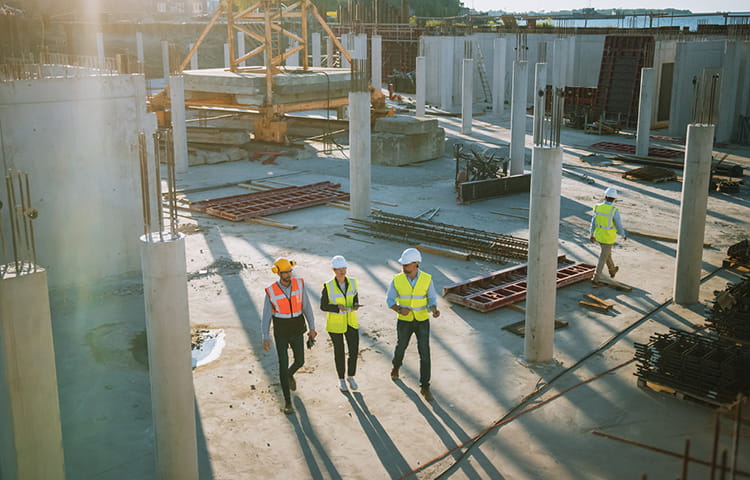

Insights
Industrial Construction Pipeline Resets to Normal After Four-Year Boom
U.S. CONSTRUCTION OVERVIEW
Since 2020, 1.8 billion square feet (bsf) of industrial product has been delivered across the U.S. —surpassing the total construction output of the entire previous decade. After an over-stimulated economy pushed consumer demand for durable goods to record levels in 2021 and 2022, developers constructed industrial facilities at a feverish pace to meet occupier demand amid historically low vacancy rates. However, some economic uncertainty has persisted amid elevated inflation and high interest rates. Occupier demand has moderated, leaving 52% of the square footage built in 2023 still available for lease and causing vacancy rates to increase nationwide. As a result, new construction starts have slowed dramatically, and the under-construction pipeline has been shrinking—a phenomenon that will continue in 2024.
Record Level of Construction Delivered Each of the Past Four Years
In each of the past four years, industrial construction deliveries achieved record-breaking numbers, topping out at 610 msf in 2023. After averaging just 169 msf of annual deliveries over the previous decade, the U.S. industrial market saw those totals more than triple, delivering more than 1.1 bsf in just two years. The surge in development was in response to historic tenant demand coupled with record low-vacancy rates in many markets across the country. In 2023 alone, completions accounted for 3.7% of the nationwide industrial inventory, of which more than 80% was built on a speculative basis.
In 2021 and 2022, net absorption kept pace with the historically high construction totals achieved, as occupiers continued to expand at a brisk rate. However, headwinds in tenant demand emerged in 2023: Elevated inflation, high interest rates, and decelerating e-commerce growth led industrial users to right-size operations and optimize supply chains. Many retailers re-shifted their strategies, moving back to the “just in time” model and keeping inventory levels lower than they were during the previous few years. Absorption for the year totaled 224 msf, which was just 37% of new deliveries in 2023.
During this elongated expansion cycle, which began in 2011, speculative deliveries accounted for 60% of new construction brought to the market. Over the past two years, however, developers had a more bullish outlook due to the vigorous appetite for Class A logistics space by 3PL, e-commerce, retail, and consumer goods tenants. Speculative space accounted for 83.5% of deliveries in 2023, which was a high not seen since 2007—but the pipeline has grown slightly more cautious heading into 2024. Speculative development currently represents 75% of the U.S. industrial pipeline, an 80-basis point (bp) decline of what was delivered in 2023.
Occupiers Still Seek New, Class A Logistics Facilities
- Over the past four years, 54% of new leasing transactions greater than 50,000 sf, occurred within facilities built since 2020, although this represents just 10.7% of the nationwide industrial inventory at year-end 2023. The 1.1 bsf of transactions during this period was primarily fueled by the 100,000-300,000-sf (30%) and 500,000-1-msf (24%) size ranges.
- More recently, in 2023, 28 of the 30 largest new deals signed were within facilities built since 2022. Looking at the top 100 transactions completed in 2023, 74% of the square footage leased was in logistics product completed since 2022. Meanwhile, 42 of the 100 top transactions were concentrated in facilities not yet built.
- U.S. net absorption also continued to be fueled by the deliveries of build-to-suit or preleased speculative deliveries. In 2023, nearly all the positive absorption recorded (224 msf) was tied to newly built, occupied industrial product. Since 2021, 73% of the overall net absorption occurred within warehouse buildings constructed over the last three years.
A Shrinking Pipeline Coupled With a Shift in Development Size as We Enter 2024
As occupiers built out their supply chains throughout 2021 and 2022, we saw robust demand, specifically within spaces greater than 500,000 sf. In that three-year period, an average of 249 of these deals were completed annually, well above the levels recorded prior (132 signed in 2019). However, in 2023, demand began to shift to smaller leases (less than 300,000 sf), which led developers to focus their new developments on smaller industrial facilities. Nearly half of the square footage delivered from 2022 to 2023 was within product greater than 500,000 sf. Now, the under-construction pipeline has seen over 60% of the total, concentrated in buildings under that size threshold – with the 100,000-300,000-sf range accounting for 34.4% of the pipeline.
In each of the four U.S. regions tracked by Cushman & Wakefield, the composition of size ranges has changed, while the average building size of developments dipped region wide as 2024 began. When compared to 2023 deliveries, the average industrial facility size decreased by 12% within projects under construction. The pipelines in three of the four regions are driven by the 100,000-300,000-sf range, with only the Midwest propelled by the 500,000–999,999-sf range (32% of the total).
While the rise in the share of smaller facilities (less than 500,000 sf) has had an effect on the declining construction pipeline, the main shift has been a combination of a large number of completions coupled with the pullback in construction starts. The pipeline has shrunk by 34% over the last year, while new construction starts have fallen by 58% annually. The fourth quarter of 2023 had the lowest volume of industrial starts (32 msf) since mid-2020.
Local Market Perspective
There have been 19 North American markets that have delivered more than 30 msf of new industrial product, including Dallas-Fort Worth (155 msf), Houston (113 msf), and Atlanta (107 msf). The top 10 U.S. markets for square footage built during that period totaled 916.3 msf and accounted for nearly 50% of the nationwide total. Vacancy in these markets rose briskly, up 440 bps in Dallas-Fort Worth, 250 bps in Atlanta, and 160 bps in Houston. In 2023, there were nine U.S. markets where deliveries exceeded 20 msf, including Savannah, with a 16.8% growth in inventory that led to a 630-bps increase in overall vacancy—from 0.7% to 7.0%. This was the first time Savannah’s rate surpassed the 7% mark since the first quarter of 2015. But as the market’s pipeline dissipates over the 12 to 18 months, the rate is anticipated to nominally decline, as demand should outpace the new supply.
Topics to Dive Deeper On:
In some markets, new supply has not been widespread but concentrated in just one or a handful of submarkets. In 2023, 16.3% of the warehouse new supply was concentrated within the top 10 submarkets for annual deliveries. Of those 10 submarkets, four saw more than 10 msf of new warehouse product built in 2023. As the additional new supply came online, vacancy rates in some of these submarkets surged as high as 37.5%. However, three of the top 10 submarkets continue to have sub-10% vacancy rates.
Meanwhile, one-fifth (19.2%) of the 390 msf of warehouse and logistics product under development is located in just 10 submarkets. Two of these submarkets (North Goodyear in Phoenix and North Las Vegas) each boast more than 11 msf under construction. North Las Vegas accounts for 70% of Las Vegas’ total under construction, while 81% of the Salt Lake City pipeline is located in the North West submarket. Some of these high-construction submarkets that boast tight vacancy rates—Ontario, North Las Vegas and the I-85 Corridor, for example—will welcome the additional supply, especially as demand reaccelerates.
As of early 2024, new construction costs for warehouse and industrial facilities are down nominally— -1.5% and 0.1%, respectively on an annual basis. However, over the last six months, industrial construction costs have risen by 1.4%, while warehouse costs ticked higher by 0.6%. Both types of construction have seen costs surge by more than 40% when compared to pre-pandemic levels, as lead times, elevated inflation and increased demand have pushed costs significantly upward over the last three years. Meanwhile, non-residential contractor costs are down 1.7% on average compared to one year ago but up 1% over the last six months.
Construction commodities, like wood, steel pipes and tubes, wires, and cables, have registered price declines annually, while concrete-related products have climbed from 5% to 6.3% over that same period. Looking forward, wood, steel pipes and tubes, metal products and concrete products are projected to rise further through the remainder of 2024.
New Supply Expected to Slow
After the record number of new industrial deliveries in 2022 and 2023, new supply will surely dissipate over the next few years. Of the 452 msf of product under construction in the U.S., Cushman & Wakefield projects just over 330 msf to complete throughout 2024. In addition, we anticipate the recent decline in starts to further exert downward pressure on supply totals in 2025. Canada will see a similar trend, as new supply is projected to decline by 20% year-over-year (YOY) in 2024 and by 45% over the next two years.As this wave of new supply continues to make its way through the marketplace amid a backdrop of softer demand totals, vacancy is projected to rise in 2024 as it did last year. While new leasing activity has been fueled by newer product, we have seen vacancy rates in newly built facilities trend upwards as demand moderated in 2023.
With 75% of the current pipeline being built on a speculative basis, of which 23.5% is pre-leased, markets with healthy pipelines will experience upward pressure on vacancy. Only seven of the top 30 markets (in terms of projected warehouse delivery totals from 2024 through 2025) are forecasted to see their vacancy rates end 2025 above the 8% mark: Austin, Phoenix, Philadelphia, Indianapolis and Dallas will likely surpass 10% for their vacancy rates. Nationwide, 42 of 83 markets are expected to register overall vacancy rates at or below 6% by the close of 2025.
What does this mean going forward?
- For occupiers, the influx of speculative, Class A logistics space to the market in 2023 and 2024 will mean more options to expand their footprints or relocate. However, this will be market and submarket specific. Many high-construction markets will remain relatively tight because they also have demand in line with historical norms.
- The construction pipeline remains above long-term averages but has come down significantly from the recent peak. New starts also have receded. Deliveries will fall in coming years due to barriers of entry, higher construction costs, and developers putting the brakes on new projects until the market fundamentals and lending environment improve.
- The window of opportunity for occupiers, however, may be short-lived, as it is expected that many markets will have a resurgence in demand in 2025 and that the new supply will be absorbed more quickly than the past 18 months.
- The upwards pressure on vacancy in 2024 will help temper rent growth to the mid-single digits, with some markets registering even slower growth due to elevated rates. However, as the supply slows, and as leasing intensifies alongside a decrease in vacancy rates, rental rate growth in most markets is expected to swell, albeit well below the double-digit growth rates from late 2021 through 2023.
Authors

Jason Price
Senior Director, Americas Head of Logistics & Industrial Research, Global Research
Iselin, United States
Related Insights

MarketBeat
Research

Research
U.S. Manufacturing Resurgence?
